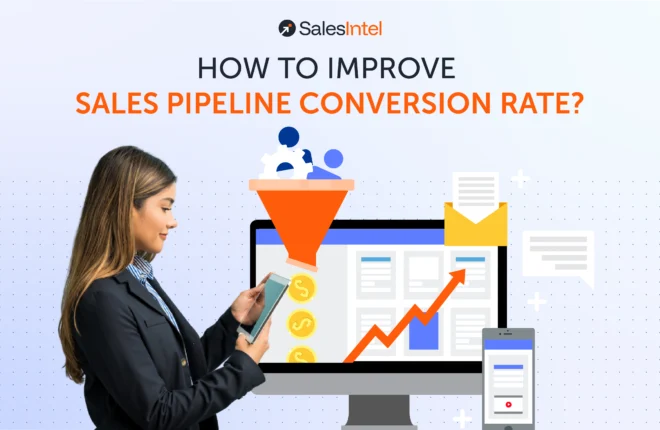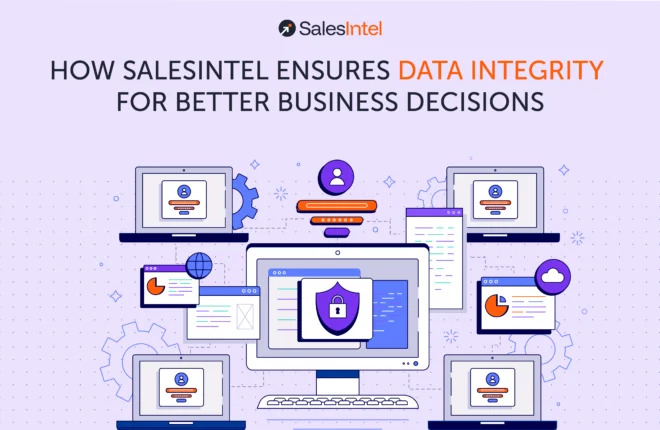In the dynamic world of B2B sales, a bustling sales pipeline is a beautiful thing. It’s filled with potential, promise, and the satisfying hum of activity. But a pipeline, no matter how full, is only as good as its conversion rate. If your leads aren’t consistently transforming into closed-won deals, that pipeline quickly becomes a leaky faucet, draining resources and frustrating your team.
Think about it: you put in all that effort to generate leads, nurture them, and get them interested. So, why are some opportunities stalling, and others simply vanishing? The answer lies in optimizing your sales pipeline’s conversion rate – the percentage of prospects that successfully move from one stage to the next, ultimately becoming paying customers.
And here’s why this isn’t just a numbers game, but a strategic imperative: The average sales conversion rate across all industries hovers around 2.9%, with B2B tech often seeing rates closer to 2.3%. This means that for every 100 leads, only about 2 to 3 are converting. Even a slight increase in that percentage can have a monumental impact on your revenue without needing to generate a single new lead!
So, how do you plug those leaks and turn your pipeline into a powerful, deal-closing machine? Let’s dive into the actionable strategies that will help you supercharge your sales pipeline conversion rate, turning more prospects into loyal customers.
Understanding Your Sales Pipeline: The Foundation of Conversion
Before you can improve something, you need to understand it inside and out. Your sales pipeline is a visual representation of your sales process, guiding prospects from initial contact to becoming a customer. Each stage in the pipeline represents a step in the buyer’s journey, and the conversion rate measures how many prospects successfully advance from one stage to the next.
Common sales pipeline stages often include:
- Lead/Prospecting: Initial identification of potential buyers.
- Qualified Lead (MQL/SQL): Leads showing interest and fitting basic criteria (Marketing Qualified Lead / Sales Qualified Lead).
- Discovery/Needs Analysis: Understanding the prospect’s pain points and requirements.
- Demo/Presentation: Showcasing your solution.
- Proposal/Negotiation: Presenting the offer and discussing terms.
- Closed-Won/Closed-Lost: The final outcome.
Why track individual stage conversion rates? Because the overall conversion rate (Leads to Closed-Won) is just the tip of the iceberg. By analyzing conversion rates between each stage, you can pinpoint exactly where prospects are getting stuck or dropping off. Is it a lead qualification problem? Are demos falling flat? Are proposals being rejected? Knowing the bottleneck is the first step to fixing it.
The Pillars of High Sales Pipeline Conversion
Improving your conversion rate isn’t about one magic bullet; it’s about a holistic approach that refines every aspect of your sales process.
Pillar 1: Precision Targeting & Lead Qualification
One of the biggest culprits behind low conversion rates is a poorly qualified pipeline. If you’re filling your pipeline with leads who are a bad fit, they’ll inevitably drop off, dragging down your conversion rates.
- Define Your Ideal Customer Profile (ICP): We’ve talked about this before, but it bears repeating. A clear ICP helps you identify the companies that truly need and will benefit from your solution. When you focus on prospects who are a perfect fit, your value proposition resonates, and they’re more likely to convert.
- Implement Robust Lead Scoring: Not all leads are created equal. Use lead scoring (based on firmographic fit, technographic alignment, engagement, and intent signals) to prioritize prospects with the highest potential. This ensures your sales team spends their valuable time on leads most likely to close.
- Align Sales and Marketing: A disconnected approach between these teams is a conversion killer. Marketing needs to know what a “sales-ready” lead looks like, and sales needs to trust the quality of leads they receive. Consistent messaging and shared goals across the revenue team are non-negotiable.
- SalesIntel’s Edge: This is where SalesIntel becomes your secret weapon. Our comprehensive firmographic and technographic data empowers you to build precise ICPs. You can filter millions of companies by size, industry, revenue, and even the software they use. Then, our actionable buyer intent data (powered by Bombora) identifies which of those ideal companies are actively researching solutions like yours. This means your team is engaging warm, relevant prospects right from the start, dramatically improving your lead-to-opportunity conversion rates.
Pillar 2: Optimized Sales Process & Methodology
A chaotic or inconsistent sales process is a surefire way to lose deals. A well-defined, repeatable process provides clarity for your reps and a smooth journey for your prospects.
- Clearly Define Pipeline Stages: Every stage should have a clear definition, entry criteria, and exit criteria. What actions need to happen for a deal to move from “Discovery” to “Demo”?
- Standardize Sales Activities: While flexibility is good, core activities at each stage should be consistent. What information must be gathered during discovery? What are the key takeaways from a demo?
- Focus on Value, Not Just Features: Prospects don’t buy products; they buy solutions to their problems. Train your reps to uncover pain points and articulate how your solution specifically addresses them, rather than just listing features.
- Effective Objection Handling: Objections are a natural part of sales. Equip your team with strategies and practiced responses to common objections. This builds confidence and prevents deals from stalling.
- Consistent Follow-Up Strategy: Time kills deals. Develop a systematic approach to follow-ups at every stage. This includes not just when to follow up, but how (email, phone, LinkedIn) and with what value.
- SalesIntel’s Edge: Once you’ve identified the right companies, SalesIntel provides human-verified contact data, including direct dials and mobile numbers. This cuts through the noise, ensuring your reps can actually connect with decision-makers to execute your refined sales process. Fewer gatekeepers, more conversations, higher conversion rates. Our accurate data supports a consistent and effective outreach strategy.
Pillar 3: Sales Rep Enablement & Coaching
Your sales team is the engine of your pipeline. Investing in their skills and providing the right tools will directly impact your conversion rates.
- Ongoing Sales Training: Sales isn’t a “set it and forget it” skill. Regular training on product knowledge, sales methodologies, communication skills, and objection handling is crucial.
- Personalized Coaching: Review individual rep performance. Where are they struggling in the pipeline? Is it qualification, discovery, or closing? Targeted coaching can yield significant improvements.
- Sales Enablement Tools: Provide your team with the right resources: updated sales collateral, compelling case studies, competitor battle cards, and effective demo scripts. Make it easy for them to access and use these materials.
- CRM Adoption & Data Hygiene: A CRM is only useful if it’s used consistently and accurately. Ensure reps are logging activities, updating deal stages, and maintaining clean data. This data is vital for accurate pipeline analysis and forecasting.
- Celebrate Wins & Learn from Losses: Acknowledge successful conversions and analyze closed-lost deals. What went wrong? Was it a bad fit, a competitive loss, or something preventable in your process? Use these insights for continuous improvement.
Pillar 4: Leveraging Technology for Automation & Insights
In 2025, trying to manage your sales pipeline manually is like trying to build a skyscraper with a shovel. Technology is no longer a luxury; it’s a necessity for optimizing conversion rates.
- CRM System: A robust CRM (Customer Relationship Management) system is the central nervous system of your sales operation. It helps track leads, manage opportunities, automate tasks, and provide a clear overview of your pipeline.
- Sales Engagement Platforms (SEPs): Tools that automate personalized outreach sequences, track email opens, clicks, and replies, and help manage follow-ups. They ensure consistent communication at scale.
- Sales Intelligence Platforms: (Like SalesIntel, naturally!) These platforms provide the crucial data to fill, qualify, and accelerate your pipeline. They are the intelligence layer that makes all other tools more effective.
- Analytics & Reporting Tools: Don’t just collect data; analyze it! Use dashboards and reports to monitor conversion rates at every stage, identify trends, and pinpoint bottlenecks. This data-driven approach allows for rapid adjustments and continuous optimization.
- AI for Predictive Analytics & Personalization: AI is increasingly helping predict which leads are most likely to convert, suggest next best actions for reps, and even assist in generating personalized messaging.
- SalesIntel’s Edge: SalesIntel integrates seamlessly with leading CRMs (Salesforce, HubSpot) and SEPs (Outreach, Salesloft), ensuring that our accurate firmographic, technographic, and contact data flows directly into your existing workflows. This means your reps are always working with the freshest, most relevant information, reducing manual data entry and increasing their efficiency. Our platform isn’t just about giving you numbers; it’s about giving you actionable insights that translate directly into improved conversion rates.
Key Metrics to Track for Sales Pipeline Conversion Rate Improvement
You can’t improve what you don’t measure. Here are the essential metrics to monitor:
- Overall Sales Pipeline Conversion Rate: (Total Closed-Won Deals / Total Leads in Pipeline) x 100. This is your big picture number.
- Stage-by-Stage Conversion Rates: The percentage of deals that move from one stage to the next (e.g., Lead-to-MQL, MQL-to-SQL, Demo-to-Proposal, Proposal-to-Closed-Won). This reveals your specific bottlenecks.
- Sales Cycle Length: The average time it takes for a deal to move from initial contact to closed-won. Shorter cycles often correlate with higher conversion rates.
- Average Deal Size: Are you converting small deals, or are your valuable, larger opportunities also making it through?
- Win Rate by Sales Rep: Identify top performers and those who might need more coaching.
- Reasons for Closed-Lost Deals: Categorize why deals are lost (e.g., budget, competition, no decision, poor fit). This feedback is invaluable for refining your process and targeting.
Common Pitfalls That Tank Conversion Rates (And How to Avoid Them)
- Poor Data Quality: Outdated, inaccurate, or incomplete data leads to wasted efforts, bounced emails, and frustrated reps. This is why human-verified data is so critical.
- Lack of Personalization: Generic outreach signals you don’t understand the prospect’s unique needs, leading to immediate disengagement.
- Too Much Focus on Quantity, Not Quality: A pipeline overflowing with unqualified leads is a false economy. Prioritize quality over sheer volume.
- Inconsistent Follow-Up: Leads go cold if you don’t engage them consistently and provide value at each touchpoint.
- Ignoring Pipeline Bottlenecks: If you see a significant drop-off at a particular stage, don’t just accept it. Investigate, analyze, and implement solutions.
- Not Aligning Sales and Marketing: When these teams operate in silos, lead handoffs become clunky, messaging becomes inconsistent, and conversion suffers.
Your Blueprint for a Conversion-Driven Pipeline
Improving your sales pipeline conversion rate isn’t a quick fix; it’s a commitment to continuous optimization. It requires a blend of precise data, a well-defined process, empowered sales professionals, and smart technology.
By focusing on attracting the right leads, guiding them through a streamlined and personalized sales journey, and continuously learning from your data, you can transform your pipeline from a series of hopeful opportunities into a predictable engine of revenue growth.
Don’t let your sales potential leak away. Start by auditing your current pipeline, identifying your specific conversion challenges, and then strategically implementing the improvements discussed here. Equip your team with the insights they need, and watch your conversion rates – and your revenue – soar.
Ready to build a more efficient, high-converting sales pipeline?
Discover how SalesIntel’s accurate data and insights can help you transform your sales process and drive better conversion rates. Book a demo today!




